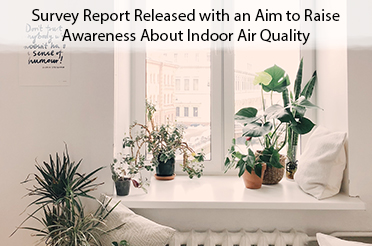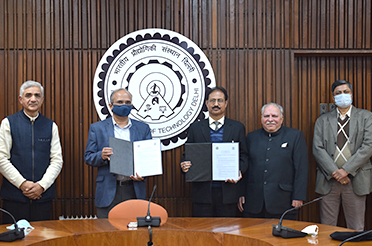Publish Date: 20th February 2021
Survey Report Released with an Aim to Raise Awareness About Indoor Air Quality
Share this on

Awareness about the quality of air that we breathe indoors is very important as people spend more than 90% of their daily time in indoor environments.
In order to find out the quality of air that we breathe indoors in different buildings spaces and to generate public awareness about the importance of indoor environment, Centre of Excellence for Research on Clean Air (CERCA), IIT Delhi; Society for Indoor Environment (SIE), and Kaiterra, an air quality instrument company, conducted a baseline survey on the state of indoor air quality in various buildings across Delhi such as schools, colleges, hospitals, restaurants, residential buildings and cinemas in 2020.
The findings of the Project MAQUID (Monitoring of Air Quality in Urban Indoors in Delhi) were released today.
Background of the Study
- The deteriorated Indoor Air Quality (IAQ) with high levels of air pollutants can have much more severe impacts on the health of the people as almost 80-90% of our total times are spent in such buildings. World Health Organization (WHO) has designated indoor air pollution (IAP) as one of the four most critical global environmental problems in developing countries.
- This contributes ~28% (i.e. 2 million) of all deaths and 39 million disability adjusted life years each year due to unvented burning of biomass for heating and cooking purposes.
- However, a far less attention has been paid to the IAP issues in urban areas due to complex nature and types of indoor environments, though an equally important issue. Apart from biomass fuel burning, multiple sources of IAPs can co–exist in urban buildings, such as tobacco smoking, building materials, indoor occupant activities and poorly maintained ventilation systems, which can contribute to worse the levels of IAP.
- The pollutants, which are of prime concern could be particulate matter (PM), gases, biological aerosols and volatile organic compounds (VOCs) according to the existing studies on different buildings across the world, which can affect the health and wellbeing of the occupants. But due to lack of compliance for indoor air pollution in India, the matter of IAP is not yet taken so consciously.
- However, sensing the importance of IAP studies in India, an effort has been made by the group of researchers from Centre of Excellence in Research on Clean Air (CERCA), IIT Delhi and Society for Indoor Environment (SIE), India in association with Kaiterra, an air quality instrument company to map the indoor air quality in different indoor environments in the city of Delhi, which is on the top of the list of 20 most air polluted cities across the globe.
Description of the Study
- The study was conducted on total 37 buildings across Delhi including the schools, colleges, hospitals, shopping malls, restaurants, offices and cinema halls (considered to be the priority indoor environments, where chances of exposure to indoor air pollutants are maximum) during the critical winter period for the city starting from 15th October 2019 - 30th January 2020.
- 24-hour monitoring was conducted in most of the selected buildings for indoor air pollutants, including PM10, PM2.5, TVOC along with comfort parameters (Temperature, Relative Humidity and CO2 concentrations) using Sensedge® air quality monitors from Kaiterra®, which is a medium cost sensor based monitor designed specifically for monitoring of Indoor air quality.
- The physical characteristics, such as number of doors and windows, air purifiers, air conditioning systems, carpets, furniture, photocopiers and printers inside the building, running of diesel generator sets, distance of the buildings from the road sides with heavy traffic are also recorded during the study.
Findings of the Study
- The concentration of particulate matter (both PM10 and PM2.5) are recorded 2-5 times higher than the permissible limits set by Central Pollution Control Board for ambient air quality, 100 μg/m3 for PM10 and 60 μg/m3 for PM2.5 (NAAQS, 2009) in India and 10-15 times higher than the WHO 24 hours average limits (50 μg/m3 and 25 μg/m3 PM10 and PM2.5 respectively) for all the monitored buildings (WHO,2016).
- The educational institutes (schools and colleges) top the list for high PM concentration.
- Despite ban on tobacco smoking in public spaces, it was observed that people were rampantly smoking in offices, hospitals and colleges.
- The TVOC levels are also recorded high with highest in hospitals and restaurants due to rampant use of chemical cleaning agents, floor cleaners and cooking oils.
- The CO2 levels are also recorded high in hospitals, colleges, offices as well as in restaurants due to higher occupancy and inadequate ventilation. Though schools too have higher occupancy but all the selected schools are naturally ventilated so CO2 levels are within the permissible limits except one or 2 schools as defined by ASHRAE. The indoor/outdoor (I/O) ratios are calculated for PM10 and PM2.5 in the selected microenvironments. The schools fared the worst with the PM2.5 I/O ratios being reported more than one in all the selected six schools. I/O ratio more than one indicated the presence of a potential source indoors.
- After schools the microenvironments which followed were the colleges, offices, restaurants, hospitals and shopping malls.
The highlighting factors from the findings of the study for research on IAQ research in India are:
- Concentrations of outdoor air pollutants penetrating to the indoor environments.
- Building materials with high TVOC compounds.
- Indoor agents, like paints, glues, polishing materials perfumes, spray propellants and cleaning agents.
- Building characteristics such as the air tightness and ventilation.
- Building occupancy and living space.
- Equipment used within the buildings (e.g. photocopiers, printers, heaters).
- The customs, habits and traditions of the residents.








